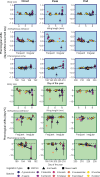Species' traits modulate rapid changes in flight time in high-Arctic muscid flies under climate change
- PMID: 40628477
- PMCID: PMC12308332
- DOI: 10.1098/rspb.2025.0970
Species' traits modulate rapid changes in flight time in high-Arctic muscid flies under climate change
Abstract
Insects are experiencing notable phenological shifts owing to climate change, with substantial interspecific variability. However, our understanding is limited by a shortage of long-term studies, beyond Lepidoptera. This study presents a hierarchical modelling framework to analyse the phenological distribution of 11 muscid fly species across three vegetation types over 18 years (1996-2014) in Zackenberg, Northeast Greenland. We examined species-specific changes in phenology and assessed ecological traits for explaining interspecific variation. Additionally, we investigated the associations between phenological shifts and timing of snowmelt and temperature. We found consistent trends of earlier flight activity and interspecific variation in responses, with smaller species shifting their end-of-the-season activity at faster rates than larger species. Flight activity was strongly associated with the timing of snowmelt, while warming was linked to an earlier end-of-the-season activity. Late-active species exhibited more pronounced shifts in response to climate variations than early-active species. This study highlights that the species-specific climate sensitivity of high-Arctic muscid flies potentially has demographic effects if temporal overlap among interacting species changes. We advocate for prioritizing species-specific insect population studies, ideally analysed within the context of interacting species, to understand better and address disparities in responses to climate change.
Keywords: Arctic; climate change; insects; long-term monitoring; phenology; species traits.
Conflict of interest statement
We declare we have no competing interests.
Figures



References
-
- Cohen JM, Lajeunesse MJ, Rohr JR. 2018. A global synthesis of animal phenological responses to climate change. Nat. Clim. Chang. 8, 224–228. ( 10.1038/s41558-018-0067-3) - DOI
MeSH terms
Grants and funding
LinkOut - more resources
Full Text Sources
Medical
